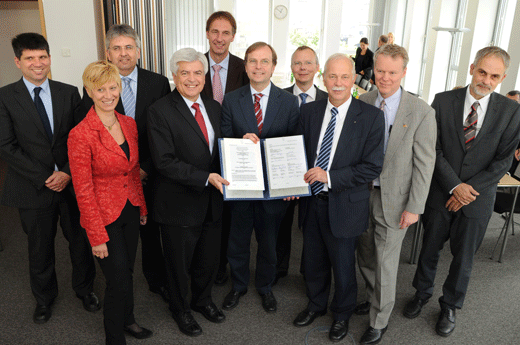- News
24 June 2011
NREL and Helmholtz Association collaborating on next-gen PV
The US Department of Energy's National Renewable Energy Laboratory (NREL) and Germany's Helmholtz Association have signed a memo of understanding (MOU) to work together more closely in order to close gaps in solar energy research and accelerate the development of new technologies.

Picture: Contract signing in Berlin. Photo: Helmholtz/Ausserhofer.
The MOU was signed in Berlin by NREL director Dan Arvizu, and leaders of three research institutes within the German Helmholtz Association: the Research Center Jülich (Forschungszentrum Jülich, FZ Jülich), the Helmholtz Center Berlin (Helmholtz-Zentrum Berlin für Material und Energie, HZB), and the German Aerospace Center (Deutsches Zentrum für Luft- und Raumfahrt, DLR). Also present for the signing were Greg Delawie (Deputy Chief of Mission, US Embassy) and Thomas Rachel (Parliamentary State Secretary of the Federal Ministry of Education and Research).
The MOU identifies several key solar energy topics to explore for joint research cooperation.
Scientists from the two countries, among other endeavors, will cooperate to synthesize and characterize novel materials that are candidates for more efficient solar cells and solar fuels.
The will also develop and use fast imaging techniques to help characterize thin-film materials on the micron to nanometer scale, and to characterize in-situ growth processes.
The researchers will seek a fundamental understanding of grain boundary/interface passivation in thin-film silicon and search for the potential and limits of wide-bandgap thin-film solar cells. Thin films, made of copper, indium, gallium, selenium (CIGS) and other emerging materials, could replace silicon as the most efficient materials in next-generation thin-film solar arrays, it is reckoned.
To measure the performance and reliability of solar cells and modules, the scientists will use electroluminescence, photoluminescence and thermography. They will also investigate the stability of solar cells by subjecting them to high temperatures and light exposures.
New device structures and lower-cost catalysts will also be investigated for the generation of hydrogen in photocatalytic solar fuel generation.
“This agreement promises to advance the state of knowledge and the development of new materials and technologies that will form the basis of next-generation solar cells and solar fuels,” says Arvizu.
In one area, the work builds on an MOU that NREL signed two years ago with DLR that involved developing standard test methods to quantitatively assess the reflectance and durability of solar mirrors for concentrating solar power (CSP) systems. The MOU also called for round-robin testing of commercial reflector samples and commercial parabolic trough receivers. In the new MOU, this work will be extended to understanding fundamental mechanisms for soiling rates on CSP mirrors.
Overall, the new MOU sets the basis for collaboration on basic and applied research issues to advance the next generation of solar cells for electricity and solar fuel production, as well as addressing improvement in the performance of concentrating solar thermal power systems.
